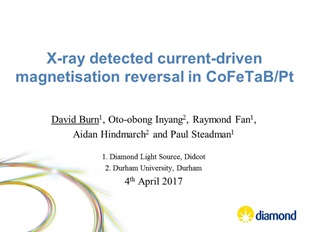
X-ray detected current-driven magnetisation reversal in CoFeTaB/Pt
D.M. Burn, O-O. Inyang, R. Fan, A.T. Hindmarch and P. Steadman
IoP Magnetism York Apr 2017
The interactions between a magnetic material and an electrical current within it are governed by fundamental physical principles based on the spin-orbit interaction. As well as being a popular area for scientific study, the potential for the development of novel technological devices is also important. So far resistance changes as a function of magnetisation, known as magnetoresistance, has been most extensively explored. Now electrical control of the magnetisation is becoming a more popular avenue to explore [1]. In particular, systems with a magnetic layer and a layer with high spin-orbit coupling give rise to interesting interfacial effects. An electrical charge current in the high spin-orbit layer generates a transverse spin current. This spin current exerts a spin-orbit torque on magnetic moments in an adjacent magnetic layer and can manipulate the magnetisation [2,3].
We have performed soft x-ray reflectivity measurements on CoFeTaB/Pt bilayers which probe the depth dependence to both the structural and magnetic properties within the system. Additionally, tuning energy to an absorption edge provides elemental selectivity and even allows the relative spin and orbital contributions to the moments to be investigated.
Both field- and current-driven magnetisation reversal hysteresis loops have been measured, which reveal a depth-dependence to the field-driven coercive field, and current-driven critical switching current density, for the system when changing the x-ray penetration depth into the sample. By applying additional static magnetic field or DC current, modifications to the hysteresis loop shape show that the current driven reversal is complex and cannot simply be described as a purely field-like effect. These modifications may be attributed to changes in the anisotropy with strong links to the spin-orbit interaction. Furthermore, circular dichroism in the x-ray absorption is only observed for the field-driven magnetisation reversal loops suggesting fundamental physical differences between the current- and field-driven magnetisation reversal processes.

Fig 1: Current-driven magnetization reversal in CoFeTaB/Pt detected by X-ray reflectivity
[1] Slonczewski, J., Journal of Magnetism and Magnetic Materials 159, L1 (1996).
[2] Miron, I. M., et al., Nature materials 9, 230 (2010).
[3] Garello, K., et al., Nature Nanotechnology 8, 587 (2013).